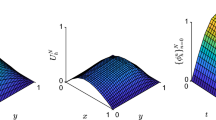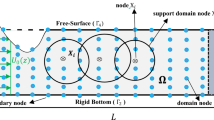Abstract
A numerical model for three-dimensional fully nonlinear free-surface waves is developed by applying a boundary-type meshless approach with a leap-frog time-marching scheme. Adopting Gaussian Radial Basis Functions to fit the free surface, a non-iterative approach to discretize the nonlinear free-surface boundary is formulated. Using the fundamental solutions of the Laplace equation as the solution form of the velocity potential, free-surface wave problems can be solved by collocations at only a few boundary points since the governing equation is automatically satisfied. The accuracy of the present method is verified by comparing the simulated propagation of a solitary wave with an exact solution. The applicability of the present model is illustrated by applying it to the problem of a solitary wave running up on a vertical surface-piercing cylinder and the problem of wave generation in infinite water depth by a submerged moving object.
Similar content being viewed by others
References
Longuet-Higgins HS, Cokelet ED (1976) The deformation of steep waves on water, I, a numerical method of computation. Proc R Soc Lond A 350: 1–26. doi:10.1098/rspa.1976.0092
Issacson M (1982) Nonlinear wave effects on fixed and floating bodies. J Fluid Mech 120: 267–281. doi:10.1017/S0022112082002766
Dommermuth DG, Yue DKP (1987) Numerical simulations of nonlinear axisymmetric flows with a free surface. J Fluid Mech 178: 195–219. doi:10.1017/S0022112087001186
Grilli ST, Skourup J, Svendsen IA (1989) An efficient boundary element method for nonlinear water waves. Eng Anal Bound Elem 6: 97–107. doi:10.1016/0955-7997(89)90005-2
Cooker MJ, Peregrine DH, Skovggard O (1990) The interaction between a solitary wave and a submerged semicircular cylinder. J Fluid Mech 215: 1–22. doi:10.1017/S002211209000252X
Ohyama T, Nadaoka K (1991) Development of a numerical wave tank for analysis of nonlinear and irregular wave field. Fluid Dyn Res 8: 231–251. doi:10.1016/0169-5983(91)90045-K
Grilli ST, Guyenne P, Dias F (2001) A fully nonlinear model for three-dimensional overturning waves over an arbitrary bottom. Int J Numer Methods Fluids 35: 829–867 doi:10.1002/1097-0363(20010415)35:7 < 829::AID-FLD115 > 3.0.CO;2-2
Tsai WT, Yue DKP (1996) Computation of nonlinear free-surface flows. Annu Rev Fluid Mech 28: 249–278
Rokhlin V (1985) Rapid solution of integral equations of classical potential theory. J Comput Phys 60: 187–207. doi:10.1016/0021-9991(85)90002-6
Hackbusch W, Nowak ZP (1989) On the fast matrix multiplication in the boundary element method by panel clustering. Numer Math 54: 463–491. doi:10.1007/BF01396324
Beylkin G, Coifman R, Rokhlin V (1991) Fast wavelet transforms and numerical algorithms I. Commun Pure Appl Math 44: 141–183. doi:10.1002/cpa.3160440202
Cao YS, Schultz WW, Beck RF (1991) 3-dimensional desingularized boundary integral methods for potential problems. Int J Numer Methods Fluids 12: 785–803. doi:10.1002/fld.1650120807
Lalli F (1997) On the accuracy of the desingularized boundary integral method in free surface flow problems. Int J Numer Methods Fluids 25: 1163–1184 doi:10.1002/(SICI)1097-0363(19971130)25:10 < 1163::AID-FLD614 > 3.0.CO;2-5
Wang QX (2005) Unstructured MEL modeling of nonlinear unsteady ship waves. J Comput Phys 210: 368–385. doi:10.1016/j.jcp.2005.04.012
Hardy RL (1971) Multiquadric equations of topography and other irregular surfaces. J Geophys Res 76: 1905–1915. doi:10.1029/JB076i008p01905
Franke C (1982) Scattered data interpolation: test of some methods. Math Comput 38: 181–200. doi:10.2307/2007474
Moody J, Darken C (1989) Fast-learning in networks of local tuned processing units. Neural Comput 1: 281–294. doi:10.1162/neco.1989.1.2.281
Kansa JE (1990) Multiquadrics—a scattered data approximation scheme with applications to computational fluid dynamics—II, Solutions to parabolic, hyperbolic and elliptic partial differential equations. Comput Math Appl 19: 127–145. doi:10.1016/0898-1221(90)90270-T
Du CJ (1999) Finite-point simulation of steady shallow water flows. J Hydraul Eng 125: 621–630. doi:10.1061/(ASCE)0733-9429(1999)125:6(621)
Du CJ (2000) An element-free Galerkin method for simulation of stationary two-dimensional shallow water flows in rivers. Comput Methods Appl Mech Eng 182: 89–107. doi:10.1016/S0045-7825(99)00087-0
Zhou X, Hon YC, Cheung KF (2004) A grid-free, nonlinear shallow-water model with moving boundary. Eng Anal Bound Elem 28: 967–973. doi:10.1016/S0955-7997(03)00124-3
Young DL, Jane SJ, Lin CY, Chiu CL, Chen KC (2004) Solution of 2D and 3D Stokes law using multiquadratics method. Eng Anal Bound Elem 28: 1233–1243. doi:10.1016/j.enganabound.2003.04.002
Ata R, Soulaimani A (2005) A stabilized SPH method for inviscid shallow water flows. Int J Numer Methods Fluids 47: 139–159. doi:10.1002/fld.801
Ma Q (2005) Meshless local Petrov–Galerkin method for two-dimensional nonlinear water wave problems. J Comput Phys 205: 611–625. doi:10.1016/j.jcp.2004.11.010
Golberg MA, Chen CS (1998) The method of fundamental solutions for potential, Helmholtz and diffusion problems. In: Golberg MA (ed) Boundary integral methods-numerical and mathematical aspects. Computational Mechanics Publications, pp.103–176
Young DL, Chen KH, Lee CW (2005) Novel meshless method for solving the potential problems with arbitrary domain. J Comput Phys 209: 290–321. doi:10.1016/j.jcp.2005.03.007
Wu NJ, Tsay TK, Young DL (2006) Meshless simulation for fully nonlinear water waves. Int J Numer Methods Fluids 50: 219–234. doi:10.1002/fld.1051
Wu NJ, Tsay TK, Young DL (2008) Computation of nonlinear free-surface flows by a meshless numerical method. J Waterw Port Coast Ocean Eng 134: 97–103. doi:10.1061/(ASCE)0733-950X(2008)134:2(97)
Grimshaw R (1971) The solitary wave in water of variable depth, part 2. J Fluid Mech 9: 611–622. doi:10.1017/S0022112071000739
Ambrosi D, Quartapelle L (1998) A Taylor–Galerkin method for simulation nonlinear dispersive waves. J Comput Phys 146: 546–569. doi:10.1006/jcph.1998.6027
Peregrine DH (1967) Long waves on beach. J Fluid Mech 27: 815–827. doi:10.1017/S0022112067002605
Nwogu O (1993) An alternative form of Boussinesq equations for near shore wave propagation. J Waterw Port Coast Ocean Eng 119: 618–638. doi:10.1061/(ASCE)0733-950X(1993)119:6(618)
Wei G, Kirby JT, Grilli ST, Subramanya R (1995) Time-dependent numerical code for extended Boussinesq equations. J Fluid Mech 294: 71–92. doi:10.1017/S0022112095002813
Gobbi MF, Kirby JT (1999) Wave evolution over submerged sills: tests of a high order Boussinesq model. Coast Eng 37: 57–96. doi:10.1016/S0378-3839(99)00015-0
Berkhoff JCW (1972) Computation of combined refraction–diffraction. In: Proc. 13th conf. eng., ASCE, Vancouver; pp. 471–490
Liu PLF, Tasy TK (1984) Refraction–diffraction model for weakly nonlinear water waves. J Fluid Mech 136: 453–466
Tang Y, Ouellet Y (1996) A new kind of nonlinear mild-slope equation for combined refraction–diffraction of multi-frequency waves. J Coast Eng 31: 3–36. doi:10.1016/S0378-3839(96)00050-6
Chen MY, Mei CC (2006) Second-order refraction and diffraction of surface water waves. J Fluid Mech 552: 137–166. doi:10.1017/S0022112005008530
Havelock TH (1931) The wave resistance of a spheroid. Proc R Soc Lond, A 131: 275–285. doi:10.1098/rspa.1931.0052
Farell C (1973) On the wave resistance of a submerged spheroid. J Ship Res 17: 1–11
Doctors LJ, Beck RF (1987) Convergence properties of the Neumann–Kelvin problem for a submerged body. J Ship Res 31: 227–234
Bertram V, Schultz WW, Cao Y, Beck RF (1991) Nonlinear computations for wave drag, lift and moment of a submerged spheroid. Ship Technol Res 38: 3–5
Cao Y (1991) Computations of nonlinear gravity waves by a desingularised boundary integral method. Ph.D. dissertation, Department of Naval Architecture and Marine Engineering, The University of Michigan
Scullen DC (1998) Accurate computation of steady nonlinear free-surface flows. Ph.D. dissertation, Department of Applied Mathematics, The University of Adelaide
Tuck EO, Scullen DC (2002) A comparison of linear and nonlinear computations of waves made by slender submerged bodies. J Eng Math 42: 255–264. doi:10.1023/A:1016131128042
Kent CP, Choi W (2007) An explicit formulation for the evolution of nonlinear surface waves interacting with a submerged body. Int J Numer Methods Fluids 55: 1019–1038. doi:10.1002/fld.1504
Author information
Authors and Affiliations
Corresponding author
Rights and permissions
About this article
Cite this article
Wu, NJ., Tsay, TK. Applicability of the method of fundamental solutions to 3-D wave–body interaction with fully nonlinear free surface. J Eng Math 63, 61–78 (2009). https://doi.org/10.1007/s10665-008-9250-2
Received:
Accepted:
Published:
Issue Date:
DOI: https://doi.org/10.1007/s10665-008-9250-2




